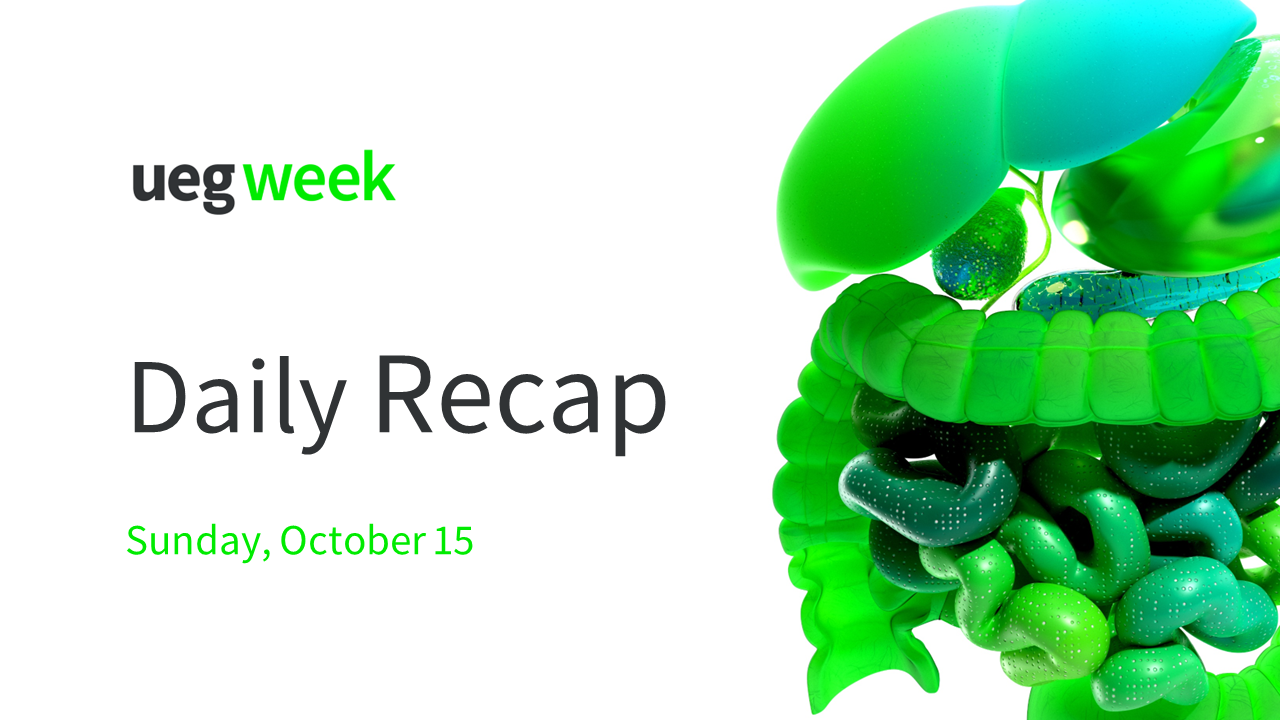
Discover Day 2’s highlights at UEG Week 2023
The second day brought more highlights from our world-class scientific programme and featured the unmissable Opening Plenary. During this engaging session, we heard from the top abstract presenters, gained insights into this year’s Research Prize and witnessed the presentation of the UEG Lifetime Achievement Award.
Read on and digest today’s standout moments.
UEG Week 2023 Opening Plenary
Julia Mayerle, Chair of the UEG Scientific Committee, commenced UEG’s Opening Plenary this afternoon (13:30 – 15:00 CEST). “A very warm welcome to the 130 nations attending this 31st UEG Week,” she commented. “To be honest, I’m overwhelmed – it’s a really packed room.”
Julia Mayerle continued, “After our anniversary last year, we have again increased the number of participants. We hosted the biggest Postgraduate Teaching programme ever with 4,560 participants. This is why I would like to start with a thank you all for your support; for participating, submitting excellent research and also volunteering as faculty.”
Later in the session, UEG President, Helena Cortez-Pinto delivered her presidential address. “Welcome to UEG Week 2023. This year, in the wonderful city of Copenhagen, we gather more than 11,000 participants. I also welcome colleagues that are watching us live via our streaming platform, which truly connects a unique and international digestive health community that has become indispensable in gastroenterology. I promise you all an exceptional programme with 450 invited facility and over 2,600 abstract presentations.”
Helena Cortez-Pinto continued, “This meeting is more than just science. It is the place to meet, make change, network and develop thorough ideas. The creation of the myUEG community aims to factor together all these efforts throughout the year, and I’m proud to see the number of myUEG associates is growing and growing.”
Helena Cortez-Pinto provided an overview of UEG’s continued advocacy work. This included the release of the latest UEG White Book, which has consolidated and identified the priority areas in digestive health across the continent.
Finally, Helena Cortez-Pinto spoke about an issue of particular importance to her, namely equality in the field. “As the first female president, I am proud to serve as a role model. I strongly believe in empowering women and minority groups. As the outgoing president of UEG, it is important for me to leave behind an orderly house and ensure that UEG continues to remain vibrant, creative and relative in the future.”
“I wish you all an unforgettable UEG Week,” she concluded.
Read on for more insights from the Opening Plenary and the wider scientific programme.

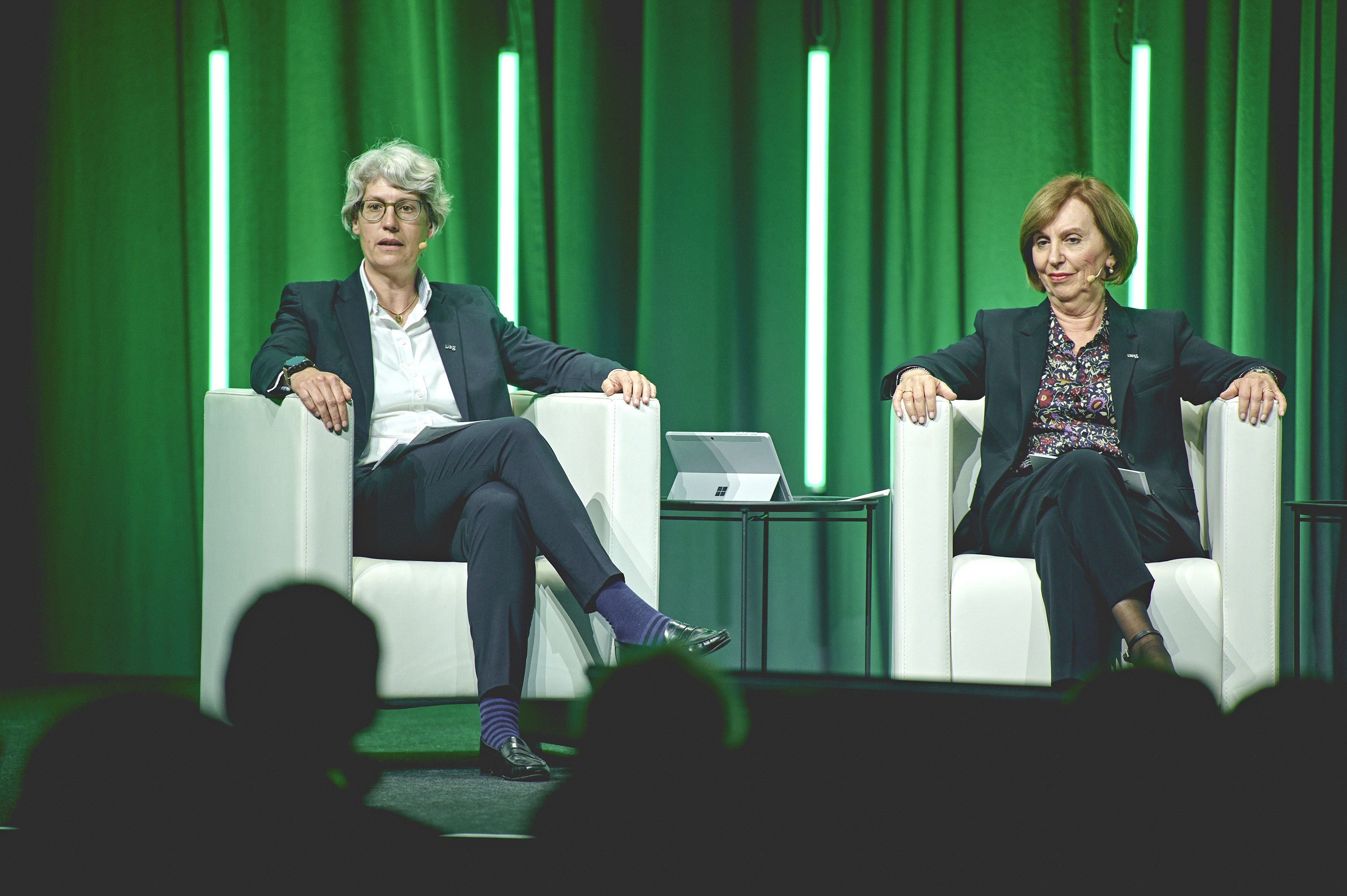
Top abstract: Resmetirom can lead to non-alcoholic steatohepatitis resolution and improve liver fibrosis
According to 52-week data from the MAESTRO-NASH randomised, double-blind, placebo-controlled Phase 3 trial, 80 to 100 mg daily resmetirom is both efficacious and safe for patients with non-alcoholic steatohepatitis (NASH) and liver fibrosis.
Resmetirom is an investigational oral thyroid receptor-β selective agonist designed to treat the underlying causes of NASH in the liver, and MAESTRO-NASH is an ongoing 54-month study testing this mechanism of action. The study has two primary endpoints of interest at Week 52; the first is NASH resolution with no worsening of fibrosis, where resolution is defined as a ballooning score of 0, inflammation score of 0 or 1 and ≥2-point reduction in non-alcoholic fatty liver disease activity score (NAS), and the second is ≥1-stage improvement in fibrosis with no worsening of NAS.
Patients (n=955) were enrolled at approximately 200 global sites, with baseline NAS scores of ≥5% in 84% of cases and baseline fibrosis of bridging (F3: 62%), perisinusoidal and portal/periportal (F2: 33%) and moderate zone 3 [liver lobule region] perisinusoidal (F1B: 5%). The majority of patients had hypertension (78%), dyslipidaemia (71%) and type 2 diabetes (67%).
NASH resolution was reported in 26% of patients taking 80 mg resmetirom (n=316) and in 30% of patients taking 100 mg (n=321) (P<0.0001). Fibrosis improvement was reported in 24% of patients taking 80 mg (P<0.001) and 26% of patients taking 100 mg (P<0.0001). This compared to 10% of patients (n=318) receiving a placebo experiencing NASH resolution and 14% fibrosis improvement. Consensus review confirmed the findings and similar results were obtained by two central pathologists.
Positive results were obtained with the secondary endpoint of percentage change from baseline low-density lipoprotein-cholesterol at Week 24. There was a -12% change with 80 mg and a -16% change with 100 mg, compared with a 1% change in the placebo group (P<0.0001). Promising findings were further obtained from additional biopsy and biomarker endpoints, including NASH resolution and fibrosis combined, ≥2-stage improvement in fibrosis, and reductions in alanine transaminase, aspartate aminotransferase and gamma glutamyl transpeptidase.
A similar number of adverse events were reported across treatment groups, with diarrhoea and nausea initially increasing in the resmetirom groups. Overall, resmetirom was well tolerated. The implication of this ongoing research is the potential to prevent progression to cirrhosis and/or advanced liver disease. The suggested therapy offers the first medical treatment of NASH.
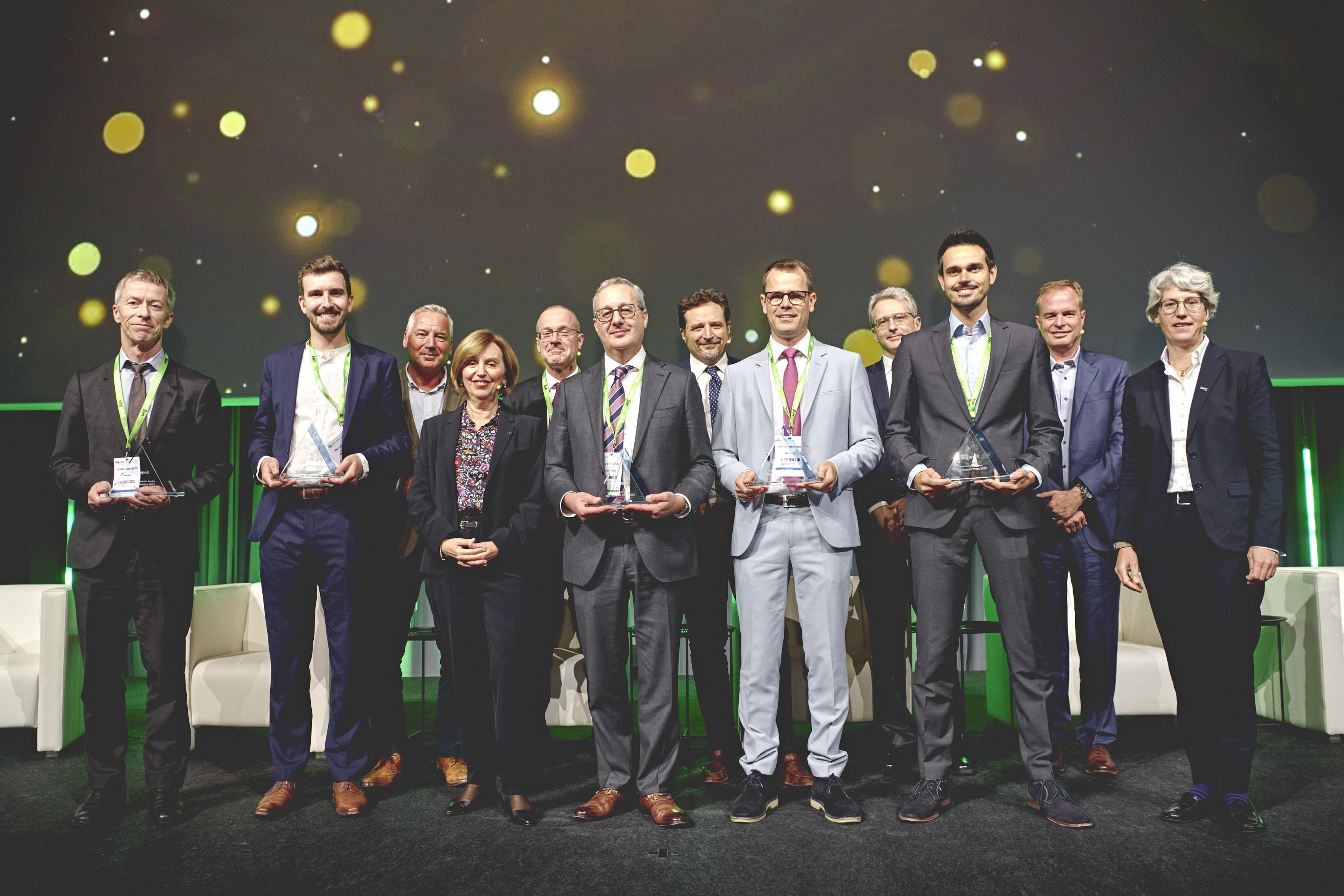
UEG Research Prize: Michael Bretthauer
In recognition of his significant impact in the field of digestive health, Michael Bretthauer, Professor of Medicine at the University of Oslo and gastroenterologist at Oslo University Hospital, has been awarded the UEG Research Prize.
This highly esteemed award, accompanied by a €100,000 grant, acknowledges excellence in basic science, translational or clinical research and aims to support a future scientific project from its early stage to successful completion.
Reflecting on this achievement, Michael Bretthauer commented, “It is a tremendous honour to be awarded the UEG Research Prize for 2023. This award is one of the highest achievements in our field and has enormous value for me and my coworkers. I feel very privileged to be a member of this distinguished group, and I thank UEG and the whole European gastroenterology community for this recognition.”
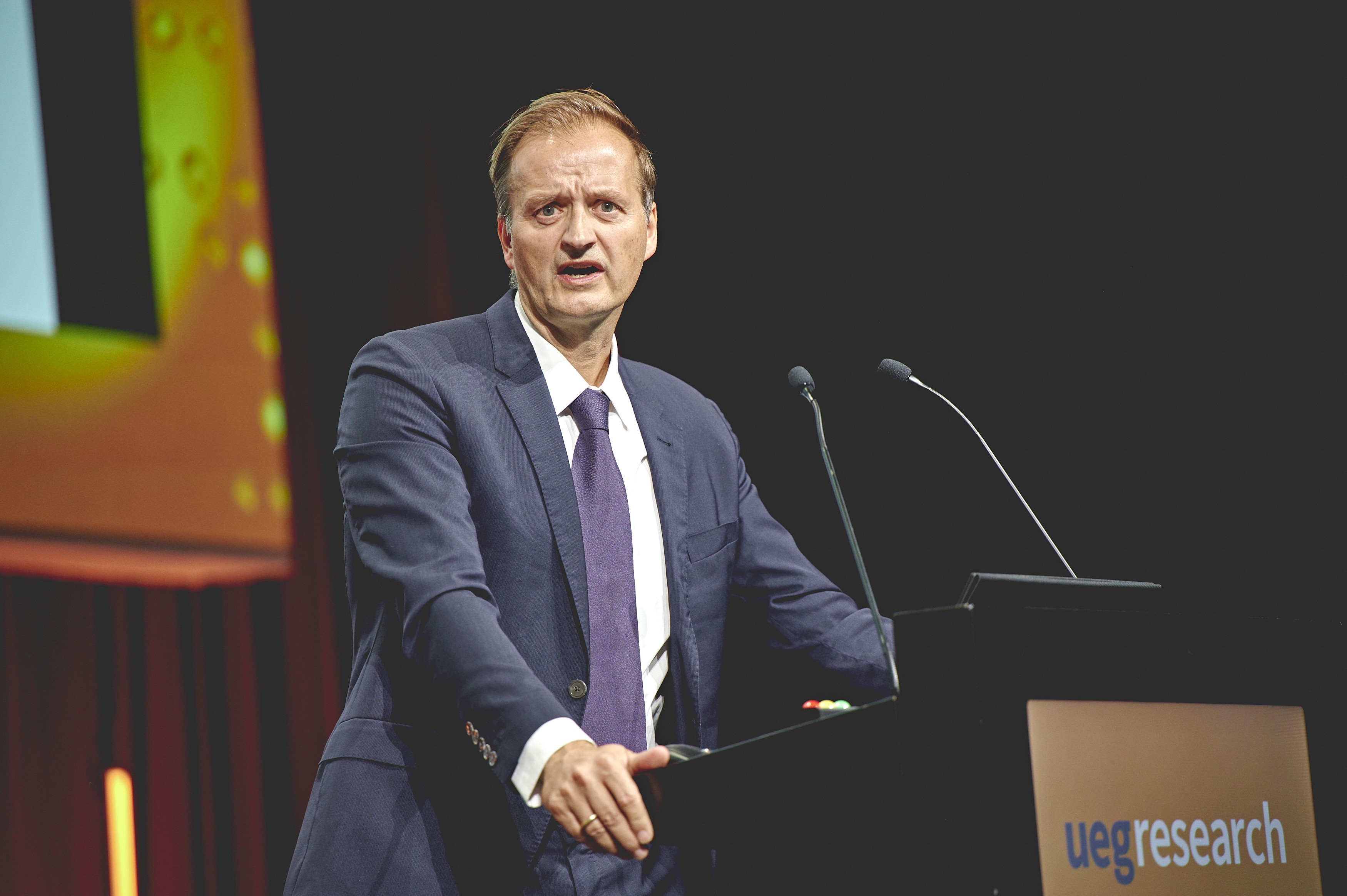
Top abstract: Computer aided detection system achieves superior performance to general endoscopists in histology
An innovative trial study reveals that computer aided detection (CADe) systems can detect extra colorectal polyps missed by endoscopists.
The early detection of colorectal cancer can improve 5-year survival rates, but only about 40% of colorectal cancers are discovered at this early stage. Given improvements in colorectal polyp detection with CADe, investigators embarked on the innovative CAD-ARTIPOD [Clinical vAliDation of ARTificial Intelligence in POlyp Detection] trial to clinically test a novel, multiplatform CADe across nine European centres.
The investigator-initiated, prospective multicentre trial is innovative in that it enabled the assessment of both CADe and endoscopist performance. Unique in its design, the CADe system combined a convolutional neural network with a recurrent neural network for detection of colorectal polyps trained in all imaging modalities. The participating endoscopists were blinded to the CADe output, while a trained second observer assessed and classified CADe output in real-time. If a polyp detected by CADe was not discovered by the endoscopist, they were unblinded for confirmation of the finding.
Out of 2141 polyps collected from 946 patients, CADe sensitivity was 0.946 compared with 0.961 for endoscopists. Therefore, the primary endpoint superiority was not reached between CADe and endoscopists. However, the CADe system detected 3.7% extra polyps that were missed by endoscopists. The false positive rate was 1.8 per minute clean withdrawal time, 36.3% of which were deemed clinically relevant. Considering histology as the diagnostic standard, CADe outperformed endoscopists with a sensitivity of 0.96 vs 0.95 (P<0.05), with an extra detection rate of 5%. Baseline polyp detection rate increased from 0.47 to 0.70 (odds ratio [OR]: 2.76; 95% confidence interval [CI]: 2.26–3.37) during the trial, while adenoma detection rate increased from 0.38 at baseline to 0.50 (OR: 1.52; 95% CI: 1.26–1.85).
Given the high miss rate of the gold standard colonoscopy, objective assessments provided by CADe systems offer the potential to drive earlier detection of cancerous polyps.

UEG Lifetime Achievement Award 2023: Jan Tack
During the Opening Plenary session, Jan Tack was presented with the UEG Lifetime Achievement Award. This prestigious accolade recognises his outstanding achievements in the field of digestive health and his significant contributions to the myUEG community.
Beginning in 2009, Jan Tack was the driving force behind the creation of TARGID, the Translational Research Center for Gastrointestinal Disorders at Leuven University, Belgium, which has evolved to become one of the leading gastroenterology research centres in the world. Currently, he holds the position of Chief of the Gastroenterology and Hepatology Division at Leuven University Hospitals, Belgium, and Professor of Internal Medicine.
Throughout his career, Jan Tack’s research interests have predominantly focused on Neurogastroenterology and Motility. With an impressive H-index of 103, he has published over 900-peer reviewed articles and contributed to more than 45 book chapters on various aspects of scientific and clinical gastroenterology. In addition to his research accomplishments, Professor Tack currently serves as the President of the Rome Foundation and President-elect of the European Association for Gastroenterology, Endoscopy and Nutrition (EAGEN).
During all these times, Jan Tack has maintained a strong connection with UEG. He joined the Scientific Committee in 2009 and became the first Editor-in-Chief of the United European Gastroenterology Journal, which he successfully led until 2018, achieving an impact factor of 3.5 in the first 5 years.
On receiving the award, Jan Tack commented, “It is a great honour to now be listed with the giants of European gastroenterology who have won the Lifetime Achievement Award since it was created. This award is also a recognition of the contribution of many excellent clinicians, researchers and true friends I had the pleasure to interact with in my career.”
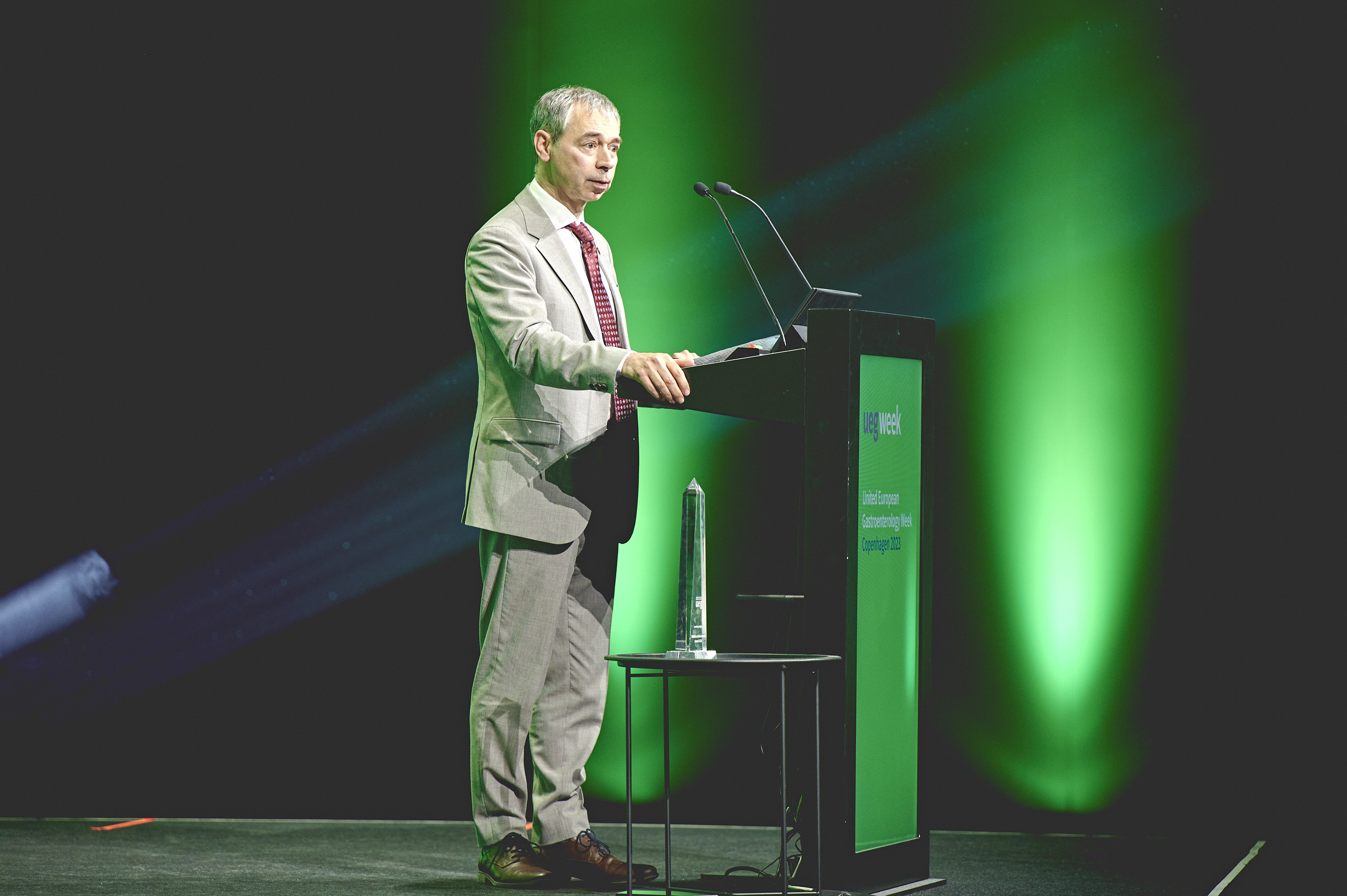
Explore the myUEG Community Area!
Throughout the entirety of UEG Week, the myUEG Community Area will provide a diverse range of exciting networking opportunities, including those designed exclusively for both women in GI and Young GIs.
For those aiming to elevate their presence and impact in the field, this space is your dedicated platform to connect with experts, awardees, volunteers, editors and role models, and both UEG Talks and UEG Journal Podcast hosts. Here, you can uncover valuable insights on maximising your first UEG Week experience, securing European funding for your research, mastering the art of writing a good paper, and much more. Everyone involved is readily available for you to chat with and discuss the burning questions you’ve always wanted to ask.
So, come and explore the myUEG Community Area to learn how you can make the most of your UEG Week experience. It’s your moment to connect, learn and grow alongside fellow professionals in the vast and diverse field of digestive health.
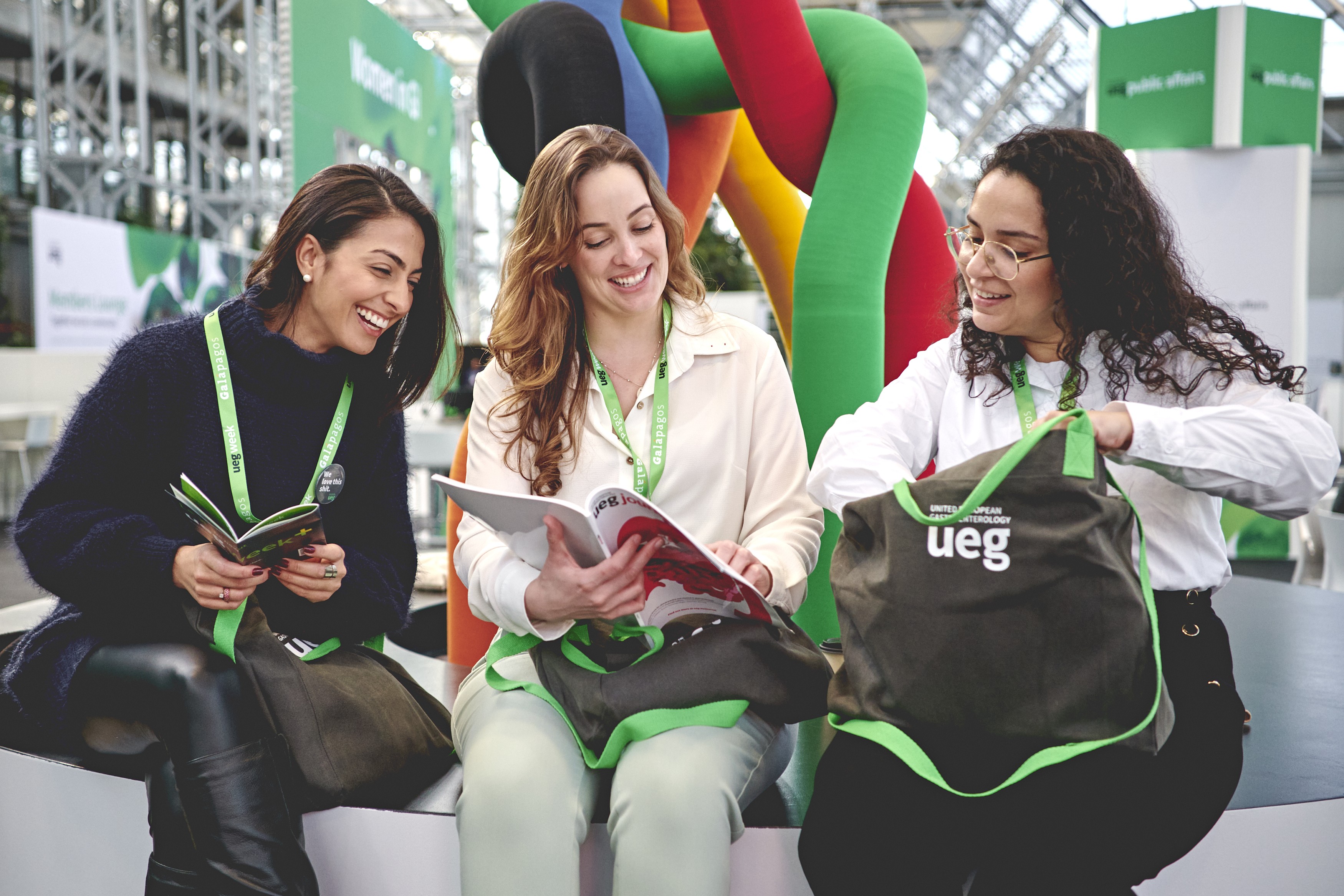
Top abstract: Long-term mirikizumab treatment is effective and safe for moderate to severe ulcerative colitis
The LUCENT-3 open-label extension study reveals that long-term mirikizumab treatment offers multiple clinical improvements for patients with ulcerative colitis (UC).
Omvoh®(mirikizumab), a humanised immunoglobulin G4 (IgG4) monoclonal antibody that binds to the p19 subunit of interleukin 23, is undergoing a three-phase clinical trial programme named LUCENT. In Phase 1, mirikizumab demonstrated clinical remission efficacy at 12 weeks, and in Phase 2, clinical remission maintenance efficacy at 52 weeks. The data presented at UEG Week 2023 was from LUCENT-3, the open-label third phase of the programme. The aim of this phase was to test whether mirikizumab efficacy and safety were maintained over the long-term in Week 52 responders (assessed by predefined decreases in endoscopic, stool frequency and rectal bleeding subscores) and remitters (assessed by predefined changes in stool frequency).
Patients received 200 mg subcutaneous mirikizumab every 4 weeks for 104 weeks. Among Week 52 responders (n=239), 74.5% demonstrated clinical response at Week 104, with remission rates of 54.0% clinical, 52.7% corticosteroid-free (CSF), 65.3% endoscopic, 47.7% histologic-endoscopic mucosal remission (HEMR), 67.8% symptomatic and 50.2% bowel urgency. Clinically meaningful improvements (CMI) were reported for histologic-endoscopic mucosal improvement (HEMI) (53.1%) and bowel urgency (67.0%; n=224), the latter of which was assessed in patients who experienced bowel urgency ≥3 at induction baseline.
Among Week 52 remitters (n=154), 76.6% demonstrated clinical response at Week 104. Remission rates were 65.6% clinical, 64.3% CSF, 77.3% endoscopic, 59.1% HEMR, 74.0% symptomatic and 51.3% bowel urgency. At Week 104, 66.2% achieved HEMI CMI and 67.3% bowel urgency CMI (n=147).
Data for biologic failed and not biologic failed subgroups were similar, with the former defined as prior inadequate response or intolerance to biologic therapy or Janus kinase inhibitors.
No new safety signals were identified, nor deaths reported, with only 2.8% discontinuation due to adverse events (AE). Severe treatment-emergent AE were reported in 4.5% of patients, while 5.2% experienced serious AE. Ultimately, long-term mirikizumab treatment for previously unresponsive moderate to severe UC safely offers clinical, endoscopic, histologic and symptomatic benefits within this challenging therapeutic area.

Spotlight on: Hospitals in crisis
In the Opening Plenary session, Marcel Levi, President of the NWO (Dutch Research Council), and Hans Kluge, WHO Regional Director for Europe, were introduced to the stage to discuss Marcel Levi’s compelling presentation, “Hospitals in crisis”. This explored the multifaceted challenges faced by healthcare systems around the world and the proposed path forward.
Beginning the session, Marcel Levi drew us back to the coronavirus pandemic. “Interestingly, after the coronavirus pandemic died down, the sense of crisis in hospitals remained in almost every country. There seems to be a shortage of staff, money and capacity, and there is still a sense that things are not going well in healthcare. But, I’m a practicing physician and this is not the sense that I’m getting. I actually think that it has never been so good, in medicine, as it is now.”
However, he did recognise the persistent and new obstacles faced by healthcare systems, including the unique challenges posed by an ageing population.
Discussing the solution, he remarked, “We have to change, we have to do things differently. And that means you need to think to yourself ‘Do I really need to train for 12 years in an academic or post-academic environment to do a sigmoidoscopy?' or is someone else able to do that as well, under my supervision, so that we can make everything much more efficient. My plea is that we move away from doing only one tiny thing, that we actually change ourselves as medical professionals who can attain the colour that is needed at this specific moment.”
When pinpointing who could initiate this change, Marcel Levi was firm in his argument that this had to come within the system itself. “We are the only ones who can do it – clinicians, doctors, nurses, dieticians, physiologists and so on. If we do not change, then the whole system will remain as it is. All these crises can be solved if we innovate ourselves.”
Hans Kluge was then invited to reflect on Marcel Levi’s viewpoints, concurring with the idea that the transformation begins at the frontline, adding that we must, also, importantly, empower patients to play their part in the healthcare journey.
They finished by discussing the collaborative opportunities with public health bodies, such as the WHO, to move forward these transformations citing the importance of the WHO’s influence and global perspective in ensuring this change is recognised across the world.
If you'd like to explore this topic in further detail, Marcel Levi was also a guest this morning at the UEGWeek+ studio, where he discussed this issue in further depth.
Watch Marcel Levi's full UEGWeek+ recording
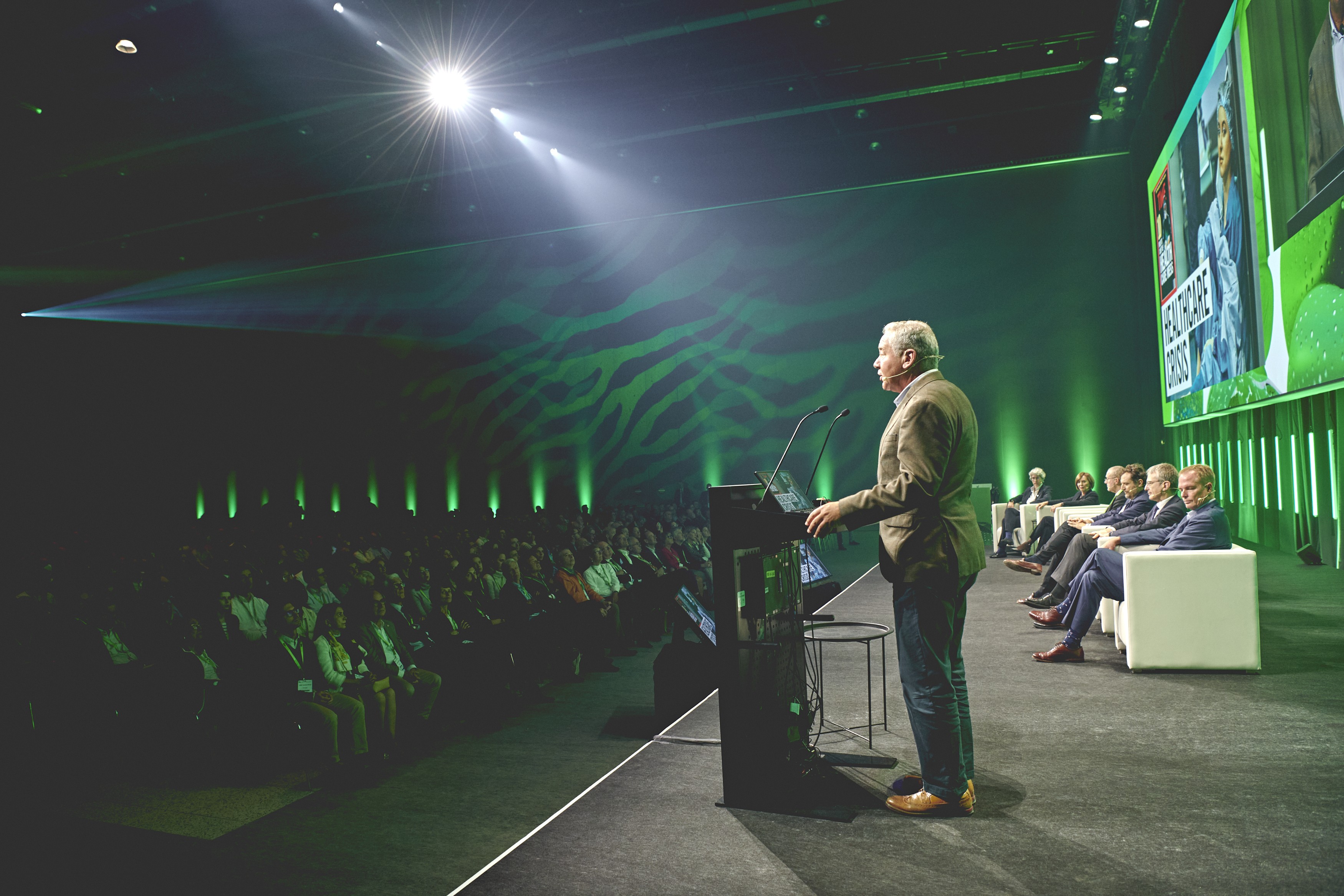
Ready, Set, Go! Compete in the Poster Rallye
The Poster Rallye – brand new to UEG Week this year – provides delegates with the opportunity to test their knowledge and win a range of exciting prizes!
To compete, simply explore the excellent exhibition of poster presentations and look out for three questions that focus on different topics. All answers can be found in the posters and speed is crucial – the fastest submission of three correct answers is the winner!
Across the four days of the congress, there are four chances to win these amazing prizes:
- UEG Week 2024 registration
- PGT 2024 registration
- A spot at the 2024 ‘Emergency Training in Endoscopy’ course
The Poster Rallye is open to both on-site and virtual delegates, ensuring everyone can join this exciting intellectual adventure. The winners will be published on the next day, at 10:00 CEST.
Good luck!
UEG Journal Best Paper Award 2023: Robert Hüneburg
Robert Hüneburg is the winner of the UEG Journal Best Paper Award for his study titled “Real-time use of artificial intelligence (CADEYE) in colorectal cancer surveillance of patients with Lynch syndrome-A randomized controlled pilot trial (CADLY).”
In this prospective trial, the effect of artificial intelligence on the adenoma detection rate in patients with a high risk of developing colorectal cancer (Lynch syndromes) was investigated. As well as being recognised for the overall study design, this research was selected for the prize because of its relevance and immediate applicability for use in clinical practice.
Robert Hüneburg commented, “This award is a great recognition of our scientific work. It creates awareness for a hereditary cancer predisposition syndrome – Lynch syndrome – which is incredibly common with 2.5 million people affected in Europe.”
“Of course, receiving this award also encourages us to continue our scientific work in the field of hereditary tumour syndromes. This was a pilot study, and we have now started an international CADLY2-trial with centres in Germany, Spain and the Netherlands. We are happy that we can now work on this topic with international experts like Evelien Dekker, Maria Pellise and Thomas Rösch. In addition, we will continue to focus on hereditary tumour syndromes, where we serve large patient populations and are working on immunological, clinical and endoscopic issues there.”
Scientific highlight: Pancreatic cancer risk at 1 year can be predicted in patients with new onset diabetes
Researchers show a 6.4-fold risk of pancreatic adenocarcinoma (PAC) in patients with new onset diabetes mellitus (NODM) and develop a PAC prediction model to identify high-risk patients.
Given the higher risk of PAC in patients with NODM, there is a critical need to determine the key risk factors that could facilitate prevention. To investigate this, researchers aimed to develop a risk prediction model for incident PAC within 1 year after diagnosis of diabetes mellitus (DM).
A territory-wide electronic healthcare database in Asia, covering the period between 2008 and 2015, was used to form two groups: the NODM group comprised adults newly diagnosed with type 2 diabetes (n=261,046), while the non-DM group included patients who had any clinical consultation without a diagnosis of diabetes (n=3,741,780). Patients with type 1 diabetes or a history of PAC were excluded. Each patient was followed from first diagnosis or consultation to PAC development, or mortality, for 1 year.
PAC incidence at 1 year was 11.68 per 10,000 (95% confidence interval [CI]: 10.41–13.07) for the NODM group and 1.82 per 10,000 (95% CI: 1.68–1.96) for the non-DM group, representing a 6.4 times higher PAC risk for patients with NODM (95% CI: 5.60–7.37). To determine clinical and predictive factors for PAC at 1 year, a logistic regression with forward stepwise was used to analyse data from 19,210 patients with NODM, 28 of whom also had PAC. The training set comprised 13,447 patients (18 PAC) and the validation set comprised 5763 patients (10 PAC).
Significant (P<0.05) predictors of PAC at 1 year baseline were older age (odds ratio [OR]: 1.06; 95% CI: 1.01–1.11), higher blood glucose (OR: 1.01; 95% CI: 1.00–1.01) and prescribed anti-diabetic medications (OR: 3.40; 95% CI: 1.92– 9.70). Larger drops in body mass index (OR: 1.24; 95% CI: 1.05–1.45) and high-density lipoprotein cholesterol (OR: 3.28; 95% CI: 1.33–8.09) 1 year before baseline were also significant predictors.
Using the validation set, the predictive model demonstrated an area under receiver operating characteristic curve of 0.89 (95% CI: 0.81–0.96), with 90% sensitivity to predicting high PAC risk and 72.3% specificity to predicting low PAC risk. Detecting 90% of high-risk cases before they occur could have a significant impact on prevention, early treatment and better outcomes for patients with NODM who are vulnerable to PAC.
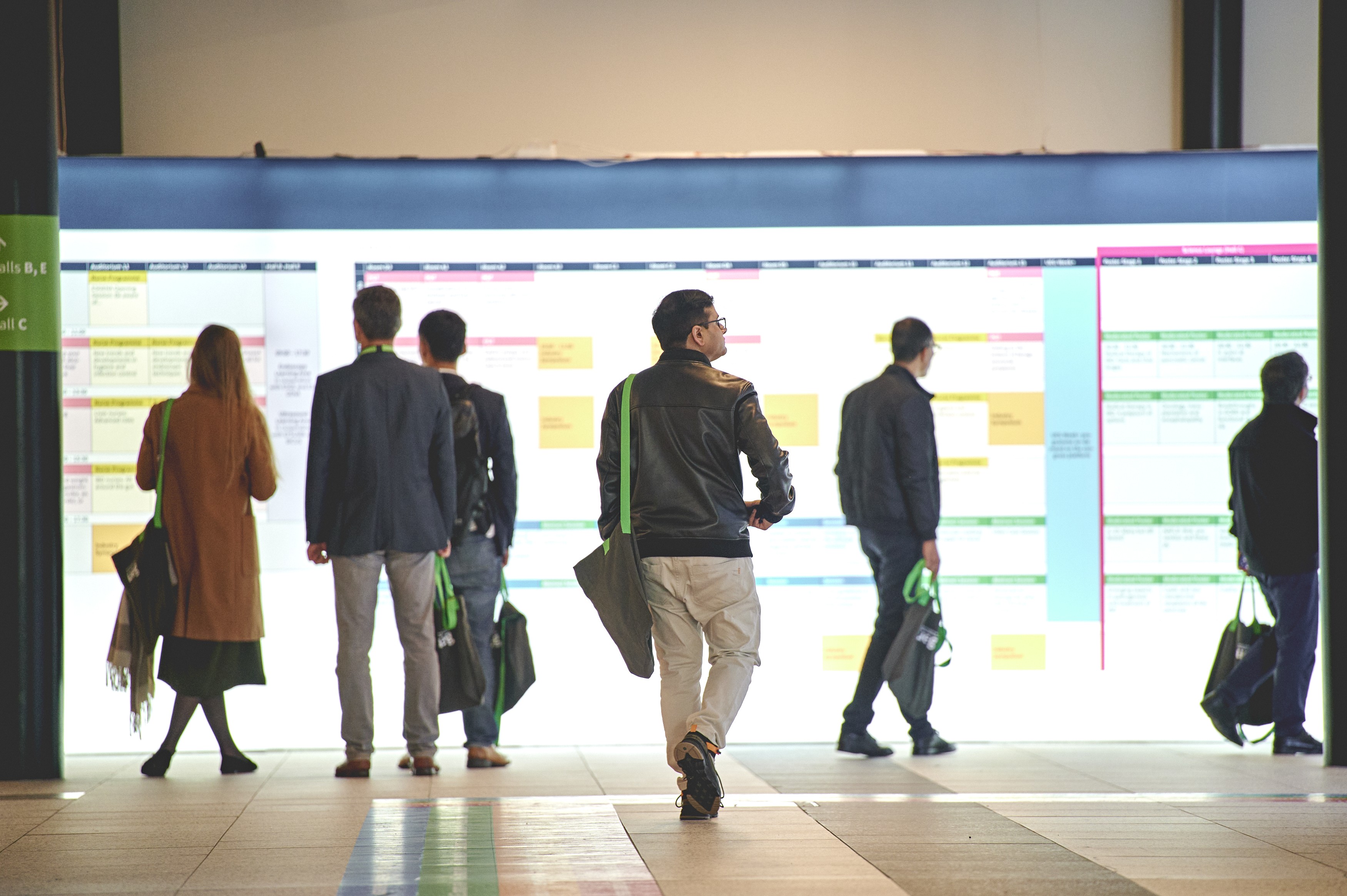
That's all for today's recap! Stay tuned for tomorrow's hottest highlights from the scientific and wider congress programme.

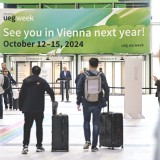

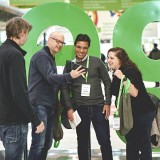
Please log in with your myUEG account to post comments.